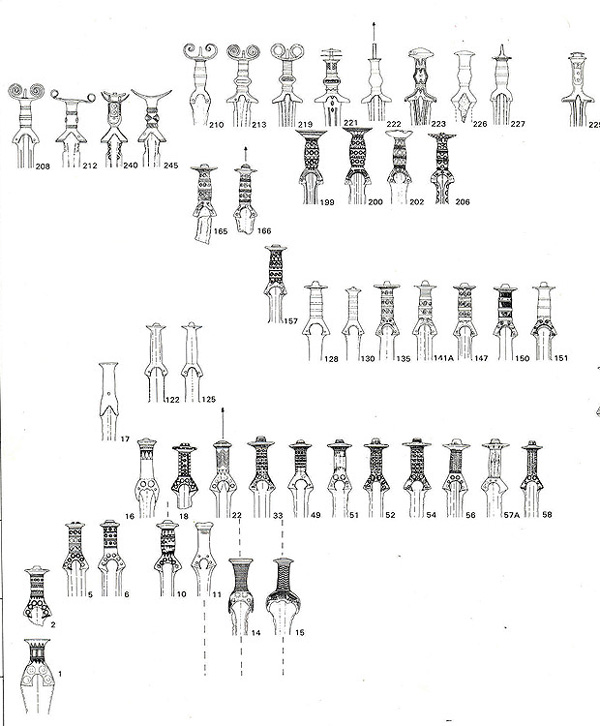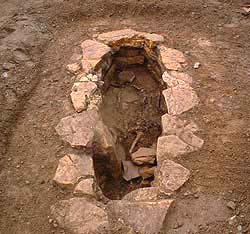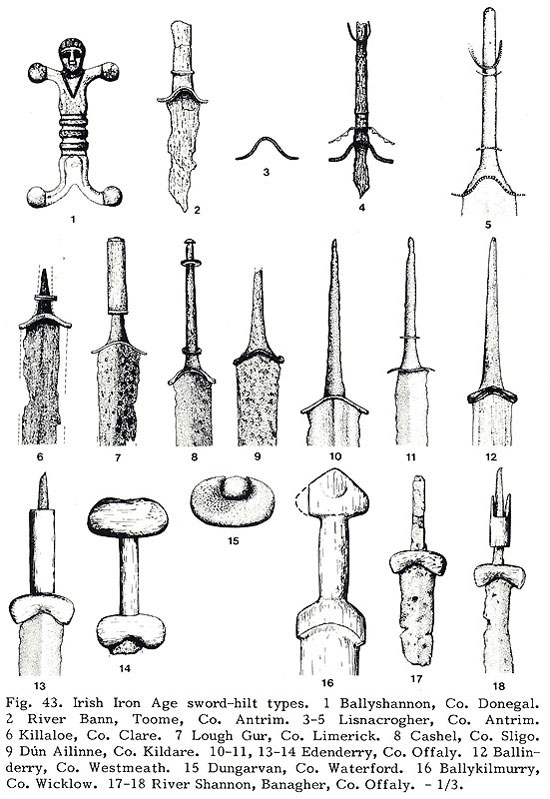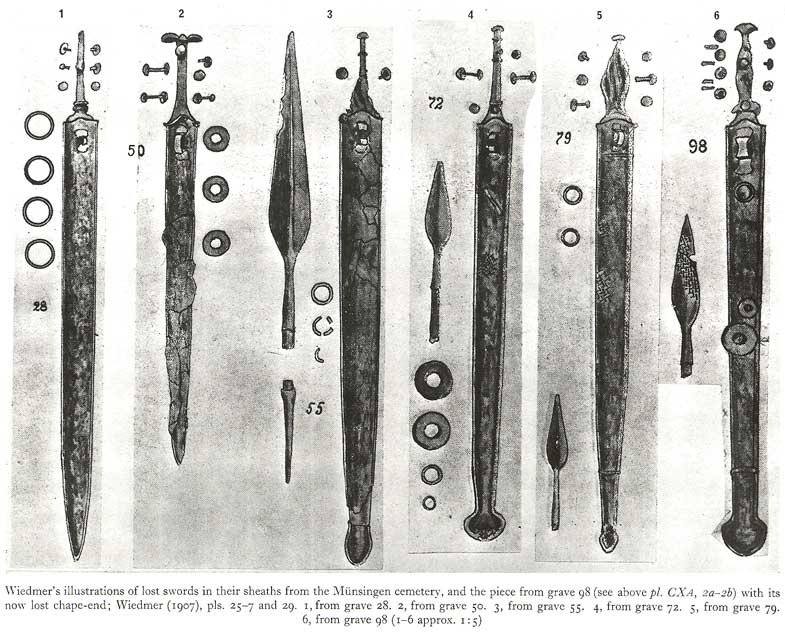| Author |
Message |
Robert W. Betten

|
 Posted: Sun 26 Sep, 2004 1:03 am Post subject: Posted: Sun 26 Sep, 2004 1:03 am Post subject: |
 |
|
i've seen it on many dug up swords (not to that extent though, but close), from the time spent in the earth the properties in the steel fill and absorb moisture causeing warpage, thats pretty drastic warpage and i've also seen period swords that had swollen twice the original width due to this absorbtion. Someone on SFI a while back when i used to be on there did a short thread about it but with more technical ways of explaining it. Anyone with more knowledge on the actual properties of how it happens may chime in...hope so at least, its quite interesting.
I personally dont see it as ritualistically damaged, not when the item is in that state...
*!*
"If the people we love are taken from us,
the way they live on is to never stop loving
them. Buildings burn, people die, but real
love is forever." - Sarah 'The Crow'
|
|
       |
 |
Folkert van Wijk

|
 Posted: Mon 27 Sep, 2004 1:09 am Post subject: Re: Oh oh, my Englisch is not that good! Posted: Mon 27 Sep, 2004 1:09 am Post subject: Re: Oh oh, my Englisch is not that good! |
 |
|
| Nathan Bell wrote: | | Folkert van Wijk wrote: | Pleas Dan, will you be so kind to explain these terms to me?
mid-rib style??
lensatic??
I couln'd find them in my dictonary  |
Lensatic or lenticular is lens-shaped in cross section, i.e., cut the blade in half and it looks like a lens shape Mid-ribbed usually refers to a radiused blade or hollowground blade that is constructed so that one ridge is raised down the center of the flats of each blade (mid-rib).
Here is a quick illustration you will see the lenticular and "hollow ground".
The Celtic sword made by Patrick Barta for me is lenticular in cross section.
I'm currently sort of working on a Celtic sword commission that is mid-ribbed. Here, this reproduction (though not accurate to the actual sword find) is mid-ribbed: |
Thanks Nathan for the explanation (i am learning all the time)
Here is an url of a reproduktion sword i would love to have a closer look on.
http://www.thelonelymountainforge.com/celtic.htm
And this is what te maker off it told me
"When I made the Celtic Chieftain sword i had not yet seen the Kirkburn sword. Though the Chieftain sword I made took a good bit of work, it's not nearly as complex as the Kirkburn sword. I cast the hand guard and pommel the old fashioned way with sand mold (heating the bronze in a small crucible in my forge. I forged and sanded the blade, heat-treated it, and mounted it to the hilt. The grip is carved of beef-bone, which is reeiforced with bronze bands I forged and rivetted shut. I cut and shaped the stone-settings out of bronze sheet, rivetted them into place, and set the stones into them.
 Attachment: 7.75 KB Attachment: 7.75 KB

 Attachment: 11.88 KB Attachment: 11.88 KB

A good sword will only be sharp, in the hands of a wise man…
I am great fan of everything Celtic BC, including there weapons.
|
|
  |
 |
|
Nathan Bell
|
 Posted: Mon 27 Sep, 2004 6:29 am Post subject: Re: Oh oh, my Englisch is not that good! Posted: Mon 27 Sep, 2004 6:29 am Post subject: Re: Oh oh, my Englisch is not that good! |
 |
|
| Folkert van Wijk wrote: | Thanks Nathan for the explanation (i am learning all the time)
Here is an url of a reproduktion sword i would love to have a closer look on.
http://www.thelonelymountainforge.com/celtic.htm
And this is what te maker off it told me
"When I made the Celtic Chieftain sword i had not yet seen the Kirkburn sword. Though the Chieftain sword I made took a good bit of work, it's not nearly as complex as the Kirkburn sword. I cast the hand guard and pommel the old fashioned way with sand mold (heating the bronze in a small crucible in my forge. I forged and sanded the blade, heat-treated it, and mounted it to the hilt. The grip is carved of beef-bone, which is reeiforced with bronze bands I forged and rivetted shut. I cut and shaped the stone-settings out of bronze sheet, rivetted them into place, and set the stones into them.
|
Hi Folkert,
I have dealt with Joe Piela both for Celtic goods and 15th century gear. I have also handled 2 of the Mainz gladii he made for some of the Roman folks, and seen other examples of his Roman gear.
The questions to be asked about his Celtic swords, are about weight, distal taper and balance, etc. The gladii I handled were very nice, but it appeared they had no distal taper, or little. This might not be quite as important in the short blade length of a gladius. However, these issues become more problematic when the blad ein question is a longsword---with somewhere between 27"---35" for La Tene II and III range.
By the way, you do know that is me, on his page with the "Boii" helm? That is some of my older gear, getting better now and more accurate. *G*
|
|
   |
 |
|
Jeanry Chandler
Location: New Orleans, Louisiana Joined: 07 Feb 2004
Posts: 62
|
 Posted: Mon 27 Sep, 2004 7:43 pm Post subject: Posted: Mon 27 Sep, 2004 7:43 pm Post subject: |
 |
|
| Sean Flynt wrote: | | Selections from the Prague Museum of Nat. History. Sorry about the terrible scan quality. The originals are sharp and detailed, but I never can get our library's scanner to work the way I want it to. I don't have any stats for these, but I do want to point out the decoration on the blade of the first one--cup and ring motif up both sides to just beyond the "ricasso" and thin decorative lines up both edges. The sides of the grip are ridged.You can see these features if you look very closely. I can provide dramatically better scans from home if anyone needs to see detailed images. |
Sean, thanks for posting these very interesting photos. Where are these located, in Prague? Are they avialble for public viewing?
The first one looks to be in incredibly good shape, you cant see much of the blade but what you can see looks almost functional. What date is this sword thought to be from?
JR
"A strong people do not ned a strong leader."
Emiliano Zapata
|
|
   |
 |
Sean Flynt

|
 Posted: Wed 29 Sep, 2004 1:52 pm Post subject: Posted: Wed 29 Sep, 2004 1:52 pm Post subject: |
 |
|
Here's a better scan of that weapon. Surprisingly, the Natural History Museum has a very good collection of Celtic/Germanic artifacts, including lots of weapons. Better yet, this is one of the few places I found in Prague that allowed photography (non-flash, of course, which is best anyway.) There's an arms & armour museum up at the castle, but it was closed for renovation in summer '03. The galleries in the NHM are pretty dim, so I was shooting at around 1/15 sec at f 1.8 with a Canon 50mm (Canon's cheapest lens, and one of its best). That's why the plane of focus is razor thin in these images. You're exactly right about the condition of that first weapon. Looks like you could just pick it up and start test cutting. The blade is thin, straight and almost pristine. Approximately .25" at the tip is slightly bent. I don't have the dating info, but I'll bet somebody watching this thread will know.
 Attachment: 114.23 KB Attachment: 114.23 KB

-Sean
Author of the Little Hammer novel
https://www.amazon.com/Little-Hammer-Sean-Flynt/dp/B08XN7HZ82/ref=sr_1_1?dchild=1&keywords=little+hammer+book&qid=1627482034&sr=8-1
|
|
   |
 |
|
Nathan Bell
|
 Posted: Fri 01 Oct, 2004 7:02 am Post subject: Posted: Fri 01 Oct, 2004 7:02 am Post subject: |
 |
|
| Sean Flynt wrote: | | Here's a better scan of that weapon. Surprisingly, the Natural History Museum has a very good collection of Celtic/Germanic artifacts, including lots of weapons. Better yet, this is one of the few places I found in Prague that allowed photography (non-flash, of course, which is best anyway.) There's an arms & armour museum up at the castle, but it was closed for renovation in summer '03. The galleries in the NHM are pretty dim, so I was shooting at around 1/15 sec at f 1.8 with a Canon 50mm (Canon's cheapest lens, and one of its best). That's why the plane of focus is razor thin in these images. You're exactly right about the condition of that first weapon. Looks like you could just pick it up and start test cutting. The blade is thin, straight and almost pristine. Approximately .25" at the tip is slightly bent. I don't have the dating info, but I'll bet somebody watching this thread will know. |
Since nobody else has answered yet...I was hoping somebody smarter than me to clear this up,
The sword there looks a little bit Halstatt era to me, possibly, but otherwise does not fit in terribly well with signature features I am used to seeing that identify a weapon as "Celtic", or rather Halstatt + La Tene eras. Perhaps a full-on shot would help with ID or dating?
Otherwise, I would have to tentatively ID it as more Germanic than Celtic, and unkown to me what time period it would be for Germanic....
Another interesting note is the 2nd photo fromt he Prague museum. I very much believe that this is in fact a quite famous anthropomorphic hilt, the only one that reaches a sword length (rather than long dagger/very short sword length). I recognize it from Clarke and Hawkes but I had to date not seen an actual photo! Thanks for posting that one!
N
|
|
   |
 |
Kirk Lee Spencer

|
 Posted: Fri 01 Oct, 2004 8:38 am Post subject: Posted: Fri 01 Oct, 2004 8:38 am Post subject: |
 |
|
I agree with Nathan. It has that late Halstatt look. Not sure of a date but it would be proto-celtic in my opinion. Here is a chart that shows the progression of hilts from Urnfield to Antenna swords. Similar hilt designs to the Prague museum piece can be seen near the top of the chart ( #240 an #225).
ks
 Attachment: 96.55 KB Attachment: 96.55 KB

Urnfield to Antenna Sword HIlts
Two swords
Lit in Eden’s flame
One of iron and one of ink
To place within a bloody hand
One of God or one of man
Our souls to one of
Two eternities
|
|
  |
 |
|
Nathan Bell
|
 Posted: Fri 01 Oct, 2004 9:32 am Post subject: Posted: Fri 01 Oct, 2004 9:32 am Post subject: |
 |
|
| Kirk Lee Spencer wrote: | I agree with Nathan. It has that late Halstatt look. Not sure of a date but it would be proto-celtic in my opinion. Here is a chart that shows the progression of hilts from Urnfield to Antenna swords. Similar hilt designs to the Prague museum piece can be seen near the top of the chart ( #240 an #225).
ks |
Hi Kirk,
It does have the late Halstatt-ish hilt look, but the fullering pattern is really throwing me off a bit and making it look a little less so....could be that I am not seeing it well from that angle though....could also be that it's Halstatt period but more Germanic (Denmark, maybe?) geographically?
What do you think, given that apparent fullering pattern?
|
|
   |
 |
|
Patrick Kelly
|
 Posted: Fri 01 Oct, 2004 9:55 am Post subject: Posted: Fri 01 Oct, 2004 9:55 am Post subject: |
 |
|
That's a very nice illustration Kirk.
Where did you get it?
"In valor there is hope.".................. Tacitus
|
|
   |
 |
David McElrea

|
 Posted: Sun 03 Oct, 2004 3:48 pm Post subject: Posted: Sun 03 Oct, 2004 3:48 pm Post subject: |
 |
|
Patrick wrote: | Quote: | That's a very nice illustration Kirk.
Where did you get it? |
I am (as they say) not Kirk, but I wouldn't be surprised if he created the chart himself-- if this isn't his, he mentioned doing something quite similar to it.
David
|
|
  |
 |
David McElrea

|
 Posted: Sun 03 Oct, 2004 3:56 pm Post subject: Posted: Sun 03 Oct, 2004 3:56 pm Post subject: |
 |
|
Can anyone tell me what the projected "ridges" are along the Lisnacrogher's tang?
I've cropped the picture to the hilt section and played with the lighting to try and show some more detail. At first I thought they were bronze or iron spacers between which (and possibly on either side of which) there would have been wood, ivory, bone, or antler-- now I am not too sure. The pommel remains as mysterious as ever, although I have played around with some ideas based upon previous suggestions. Judging by the quality of the blade itself, as well as the elaborate "shoots" I expect it would have been aesthetically pleasing... but I digress (again).
Any thoughts would be appreciated. I believe I have seen similar "spacers" or whatever on other blades, but am still unsure what to make of them.
Cheers,
David
 Attachment: 3.73 KB Attachment: 3.73 KB

|
|
  |
 |
Kirk Lee Spencer

|
 Posted: Mon 04 Oct, 2004 10:20 am Post subject: Posted: Mon 04 Oct, 2004 10:20 am Post subject: |
 |
|
| David McElrea wrote: | Patrick wrote: | Quote: | That's a very nice illustration Kirk.
Where did you get it? |
I am (as they say) not Kirk, but I wouldn't be surprised if he created the chart himself-- if this isn't his, he mentioned doing something quite similar to it.
David |
Hi Patrick and David...
Sorry for the delay. The motherboard on my computer went to that great junk heap in the sky. So I am negotiating a new computer system. For the next week or so I can only use the computer from my office at work. So at night and on the weekends I am cut off from the forums     . .
The chart in question is from a large series of archeological monographs in German (Praehistorishe Bronzefunde). I can not read German but I made copies of the charts and key archeological drawings in some of the volumes I could obtain through interlibrary loan.
ks
Two swords
Lit in Eden’s flame
One of iron and one of ink
To place within a bloody hand
One of God or one of man
Our souls to one of
Two eternities
|
|
  |
 |
Kirk Lee Spencer

|
 Posted: Mon 04 Oct, 2004 10:48 am Post subject: Posted: Mon 04 Oct, 2004 10:48 am Post subject: |
 |
|
| Nathan Bell wrote: | | Kirk Lee Spencer wrote: | I agree with Nathan. It has that late Halstatt look. Not sure of a date but it would be proto-celtic in my opinion. Here is a chart that shows the progression of hilts from Urnfield to Antenna swords. Similar hilt designs to the Prague museum piece can be seen near the top of the chart ( #240 an #225).
ks |
Hi Kirk,
It does have the late Halstatt-ish hilt look, but the fullering pattern is really throwing me off a bit and making it look a little less so....could be that I am not seeing it well from that angle though....could also be that it's Halstatt period but more Germanic (Denmark, maybe?) geographically?
What do you think, given that apparent fullering pattern? |
Hi Nathan...
It looks to me as if the blade has a wide raised domed ridge (sort of an anti-fuller) running down the center, with several grooves to the side to outline this feature. This is a typical decoration on cast bronze blades up to the time of the Antenna Swords.
I agree with Dan that the rivets look kind of fishy. You can see the decoration on the side of the hilt that is not carried over to the upper surfaces. This suggests that there may have been some kind of organic plates on the flat side of the grip and the decoration would be carried through onto the organic grip plates. If this is the case, the rivets would serve two purposes: To hold the organic grips to the sides of the hilt and to help anchor the blade "tang" onto the cast hilt. It the hilt was a separate casting onto an already cast blade then these rivets may have come in handy in securing a tighter fit. (I don't know why they did not just cast it all as one piece in the first place?)
It appears as if the rivet heads, and what ever material fills the depression around them, was added by a conservator at some point.
Also the brighter brassy looking insert in the pommel also looks as if it has been added. In my mind, I see the gap between the two elements of the pommel was filled with an organic component which probably had a shape similar to the later Antenna Sword pommels.
Just my $0.02
ks
Two swords
Lit in Eden’s flame
One of iron and one of ink
To place within a bloody hand
One of God or one of man
Our souls to one of
Two eternities
|
|
  |
 |
David McElrea

|
 Posted: Wed 06 Oct, 2004 6:18 pm Post subject: Posted: Wed 06 Oct, 2004 6:18 pm Post subject: |
 |
|
Just another brief question (still hoping someone will be able to address the previous one  ). ).
The tang on the Lisnacrogher seems to be quite round-- something I think is not uncommon with La Tene swords-- does anyone know how that affects the gripping of the organic components? I assume it is safe to say that the smiths/cutlers of the time knew what they were doing, although I would have thought the shape would lend to slippage...
David
|
|
  |
 |
David McElrea

|
 Posted: Thu 07 Oct, 2004 1:49 pm Post subject: Posted: Thu 07 Oct, 2004 1:49 pm Post subject: |
 |
|
Hi all,
You may recall that I had posted something regarding an interesting Iron-Age discovery in Alloa, Scotland. The two key points of interest were:
1) It was an Iron-Age burial-- while this is not unknown, it is quite rare, at least in Britain.
2) Within the cyst the archaeologists found a sword described as being longer than other swords found in Scotland.
Since then, a few articles have been posted:
One article notes that the “sword blade is 2ft long - much longer than the nearest equivalent found near Falkirk.”
Another article provides us with more info: "Although the shape of the sword can only just be made out now, originally it must have been very fine indeed. It had 2 central grooves, a bone grip and copper alloy pommel and guard. There is even evidence from one x-ray for pattern-welding on the blade."
And one last interesting point before I post the photos-- another source says "Evidence for a previously unknown belt arrangement, thought to be the fittings for a scabbard worn on the back were also discovered, along with possible organic materials including textiles".
Others have postulated that the above findings may have been suggestive of a baldric rather than a "previously unknown belt arrangement"-- alas, I haven't a clue.
Below you will see two photos: one of the cyst itself, and another of the sword. I have tried to sharpen up the sword with the help of some software, but didn't have tremendous success-- the original photo wasn't great. Still it gives you a sense of how the weapon may have been once....
 Attachment: 22.3 KB Attachment: 22.3 KB

The cyst at Marshill, Alloa
 Attachment: 12.77 KB Attachment: 12.77 KB

The sword from Alloa-- pattern welded? I suppose we'll have to rely on the x-rays:-)
|
|
  |
 |
|
Nathan Bell
|
 Posted: Thu 07 Oct, 2004 4:34 pm Post subject: Posted: Thu 07 Oct, 2004 4:34 pm Post subject: |
 |
|
Wow David, thanks for posting the pic. I was wondering about the appearance of that sword since the article was brought to my attention.
I will be very interested to hear about the associated finds, both for purposes of dating this blade and also to get more info on the textiles (!!!).
On your other post re: the Lisnacrogher, Raftery and several other authors have given archaelogical drawings indicating that the Lisnacrogher tang is round. A couple Irish swords with surviving grips show a round cross-section grip (also from the details in archaeological drawings).
However, in the more detailed articles and books on Continental LA Tene swords, it is quite clear that the vast majority of those blades have rectangular, at times almost square sectioned tangs. Navarro goes into detail about the cross section and tang on each of the pieces from La Tene itself...IIRC, to a one they are all rectangular/squarish in section. I think that the fact that the breadth is often smaller in proportion to blade width, when compared with medieval blades, that it sometimes gives the illusion of a round bar stock tang. However, they seem to be a narrow, but rather thick rectangle/square cross section, across the continent. I believe this was also true of the LLyn Cerig Bach swords and a few other British ones as well. I can check this later and post as I have a chance.
|
|
   |
 |
David McElrea

|
 Posted: Fri 08 Oct, 2004 11:59 am Post subject: Posted: Fri 08 Oct, 2004 11:59 am Post subject: |
 |
|
Hi Nathan,
It is quite an interesting find, no?
There were a number of other articles discovered in the grave as well.
The body was that of a man, approximately thirty years old, and thought to have died in battle (I've not heard much about any damage shown, but maybe we'll find out more soon). He is thought to have lived at around the time of Christ , give or take 200 years-- not very specific, but with some of the other articles found in the grave I would like to think they might give a more concrete date.
The sword was gripped in his hand, and rested on his chest. There was also a spear that had been placed alongside him. He was covered with a garment or shroud of white linen which was possibly held in place by an ornate copper-alloy pin. The textile itself was woven with a herring-bone effect (like twill), but the pin also had traces of fine hairs on it, which suggested that the garment may have had a fur trim.
Also found were: a glass bead (or beads?), two matching toe-rings, and a number of rings on his chest and under his back-- these rings bore traces of leather on their undersides, and are part of what has been posited as the baldric.
You can see pics of the sword, spear, and a ring here (as well as most of the info above) here:
[url]www.aocarchaeology.com/Projects/ AlloaIronAge/AlloaBurial.htm[/url]
Cheers,
David
P.S. Although the sword is looking a bit worse for wear, it's got something appealing about it, doesn't it?
|
|
  |
 |
David McElrea

|
 Posted: Fri 08 Oct, 2004 12:04 pm Post subject: Posted: Fri 08 Oct, 2004 12:04 pm Post subject: |
 |
|
Nathan Bell wrote: | Quote: | On your other post re: the Lisnacrogher, Raftery and several other authors have given archaelogical drawings indicating that the Lisnacrogher tang is round. A couple Irish swords with surviving grips show a round cross-section grip (also from the details in archaeological drawings).
However, in the more detailed articles and books on Continental LA Tene swords, it is quite clear that the vast majority of those blades have rectangular, at times almost square sectioned tangs. Navarro goes into detail about the cross section and tang on each of the pieces from La Tene itself...IIRC, to a one they are all rectangular/squarish in section. I think that the fact that the breadth is often smaller in proportion to blade width, when compared with medieval blades, that it sometimes gives the illusion of a round bar stock tang. However, they seem to be a narrow, but rather thick rectangle/square cross section, across the continent. I believe this was also true of the LLyn Cerig Bach swords and a few other British ones as well. I can check this later and post as I have a chance. |
Thanks Nathan, I would love to hear more on this when you are able-- do you think the ring-like objects on the Lisnacrogher are spacers, or are they simply fittings that have "melded" with the tang over the centuries?
David
|
|
  |
 |
Kirk Lee Spencer

|
 Posted: Sun 10 Oct, 2004 12:43 pm Post subject: LaTene Hilts with Spacers Posted: Sun 10 Oct, 2004 12:43 pm Post subject: LaTene Hilts with Spacers |
 |
|
| David McElrea wrote: | Can anyone tell me what the projected "ridges" are along the Lisnacrogher's tang?
I've cropped the picture to the hilt section and played with the lighting to try and show some more detail. At first I thought they were bronze or iron spacers between which (and possibly on either side of which) there would have been wood, ivory, bone, or antler-- now I am not too sure. The pommel remains as mysterious as ever, although I have played around with some ideas based upon previous suggestions. Judging by the quality of the blade itself, as well as the elaborate "shoots" I expect it would have been aesthetically pleasing... but I digress (again).
Any thoughts would be appreciated. I believe I have seen similar "spacers" or whatever on other blades, but am still unsure what to make of them.
Cheers,
David |
Hi David...
It seems that these spacers are not uncommon on the small sample of extant Irish swords. I have also seen similar attachments on a couple of Wiedmer's drawings of some lost early LaTene Munsingen cemetery swords. Makes me wonder if these spacers may be an indication that the migration of people (or at least this aspect of material culture) from the continent occurred in the early LaTene Period.
The fact that these spacers seem to always be in the same position on the tang with a gap of approx. 3-4 inches, makes me believe that they are probably attached to the tang and not just grip fittings. (I guess the oxidation of the tang could have held them in place. However I have seen other LaTene swords with large ring like fittings that are not stuck to the tang by oxidation.)
p.s.
Thanks for the post on the Alloa find... I simply love those "double fullered-hollow gound midrib" early LaTene blades. Nice to see one with a little length!
ks
 Attachment: 98.15 KB Attachment: 98.15 KB

Irish LaTene Hilts
Several Show Spacers
 Attachment: 86.82 KB Attachment: 86.82 KB

Weidmer's Illustrations of Lost LT swords from Munsingen Cemetery Find
 Attachment: 42.85 KB Attachment: 42.85 KB

LaTene Sword with Spacers from Cashel Co.
Two swords
Lit in Eden’s flame
One of iron and one of ink
To place within a bloody hand
One of God or one of man
Our souls to one of
Two eternities
|
|
  |
 |
Kirk Lee Spencer

|
 Posted: Sun 10 Oct, 2004 1:36 pm Post subject: Posted: Sun 10 Oct, 2004 1:36 pm Post subject: |
 |
|
| David McElrea wrote: | Just another brief question (still hoping someone will be able to address the previous one  ). ).
The tang on the Lisnacrogher seems to be quite round-- something I think is not uncommon with La Tene swords-- does anyone know how that affects the gripping of the organic components? I assume it is safe to say that the smiths/cutlers of the time knew what they were doing, although I would have thought the shape would lend to slippage...
David |
Hi David....
The Lisnacrogher blade is quite small and would not generate the torque on the grip components that a larger sword might. So... a more rounded tang may have given ample surface area to grip the organic components, especially with a little cutler's resin.
I believe that most LaTene tangs would have the typical rectangular section. Yet Navarro shows a few LaTene swords which have tangs that are very wide and have rounded edges (an elliptical section). They are so wide in some instances that they may have been functional as a grip by themselves with no organic covering being necessary. This extra mass in the tang would also help beef up the light wood hilt components and thus give such long lenticular blades better balance.
I have another off-the-wall theory in this regard...
I found a drawing in a work by Peter Connolly (I think) which shows an early LaTene sword with a twisted tang. I have never seen or heard of this sword from any other source. If such a twisted tang exists, then it could explain why the swords found at the original site seem to have such long tangs. Could it be that these blades never had hilt components. They were unfinished bare blades. The extra length would have been shortened as the tangs were twisted. This would add more mass to better balance the sword.... probably not... but an interesting conjecture.
If the tangs on the early LaTene blades were twisted this also may be the connection between the piled (layered) structure of Early LaTene and the twisted pattern-welding of Late LaTene and early Celto-Roman blades. These early bladesmiths began twisting the tangs and noticed how it welded together, they liked the patterns (maybe even noticed the tangs held up better than the blades because of the more uniform carbon distribution) and so they began twisting rods (like they twisted the tangs) and welding them into the blade.
Here is the drawing that got this crazy idea started...
ks
 Attachment: 30.28 KB Attachment: 30.28 KB

LaTene Sword w Twisted Tang
Two swords
Lit in Eden’s flame
One of iron and one of ink
To place within a bloody hand
One of God or one of man
Our souls to one of
Two eternities
|
|
  |
 |
|
|
You cannot post new topics in this forum
You cannot reply to topics in this forum
You cannot edit your posts in this forum
You cannot delete your posts in this forum
You cannot vote in polls in this forum
You cannot attach files in this forum
You can download files in this forum
|
All contents © Copyright 2003-2024 myArmoury.com — All rights reserved
Discussion forums powered by phpBB © The phpBB Group
Switch to the Basic Low-bandwidth Version of the forum
|

